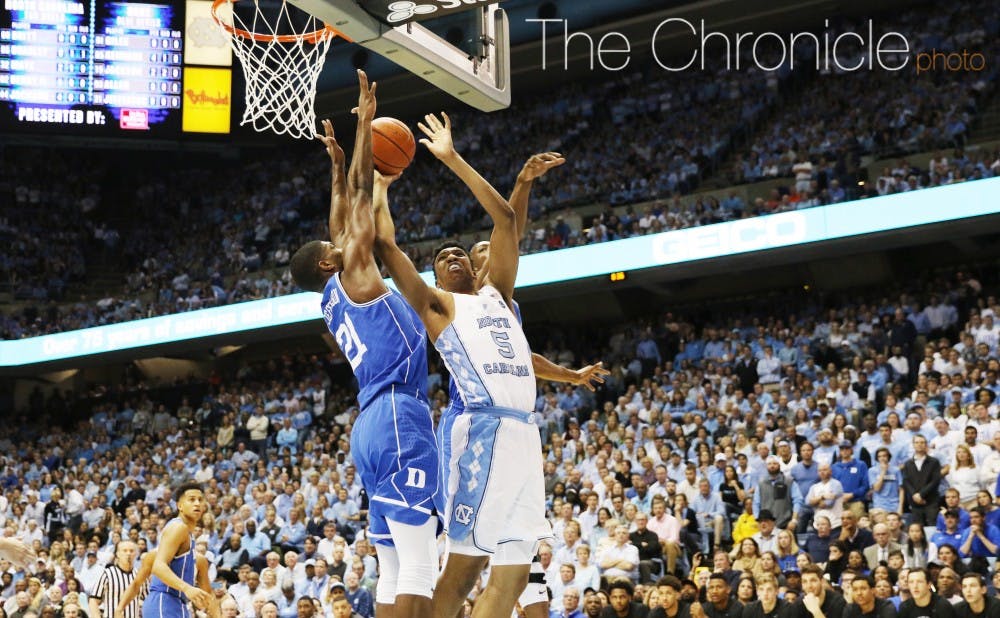CHAPEL HILL—Before the season started, Duke was supposed to be the team that would overpower opponents with its post depth, with Amile Jefferson returning and two top-20 recruits joining the frontcourt.
The last game of the regular season provided a glaring reminder of how much has gone wrong for the Blue Devil frontcourt and how little time there is to fix it.
Jefferson played well enough against No. 5 North Carolina, with 12 points and six rebounds, just a couple of boards below his season average. He also had to guard Kennedy Meeks for most of the game and held him to eight points and eight rebounds. But the 6-foot-9 graduate student got virtually no help in the post, as the Tar Heels outscored the No. 17 Blue Devils 44-26 in the paint and had 15 second-chance points in their 90-83 win.
“He’s guarding a guy 40 pounds heavier than him, and he’s trying to do everything. I thought Amile played well,” Duke head coach Mike Krzyzewski said. “He just didn’t rebound like he normally does. But overall, our rebounding was okay, it’s 35-31. I wish he had 15, but he didn’t.”
Jefferson would not have had to do everything if Krzyzewski could trust the talent that was sitting on his bench.
Harry Giles, the No. 1 recruit in the nation, was supposed to be a major contributor on the team by now after he was eased back in following a November 2015 ACL tear and preseason knee scope. He did not attempt a shot from the field and scored one point in 13 minutes, and has not scored in double figures in nearly two months.
Marques Bolden, the No. 2 center in the nation coming out of high school, was set to be a starter when Duke started preseason practice before a lower-leg injury sidelined him for three weeks. He played one minute Saturday night, did not record any stats and has not scored in Duke’s last four games.
The Blue Devils could get away with using a small lineup and keeping their prized frontcourt prospects on the bench against North Carolina Feb. 9 at Cameron Indoor Stadium, when Tar Heel forward Isaiah Hicks did not play due to a strained hamstring.
Hicks dominated smaller defenders Saturday, though, with 21 points on 7-of-9 shooting and nine rebounds in easily his best game since his injury. Freshman Jayson Tatum, a 6-foot-8 forward who has been forced to play as a stretch four for most of the year, was no match for Hicks’ size in the post and got bullied on the block on multiple possessions.
“They were really physical. In the second half, we were going back and forth. I thought a couple of those possessions, we should have gotten stops,” Jefferson said. “We have athletes. We have guys that can do it, so it’s up to us to buy in.”
Hicks also created mismatches by getting guards like Luke Kennard to switch onto him when he set screens for Tar Heel scorers Joel Berry II and Justin Jackson on the perimeter, resulting in easy interior points.
As was the case when Wake Forest frontcourtstar John Collins took Duke’s guards into the paint Feb. 18, the Blue Devils’ curious strategy allowed an opponent’s guards and big men combine to exploit size mismatches.
“I set screens for Joel, Justin, any perimeter player and they switch. They’ve got a big and I’ve got a little, so we’ve got to take advantage of either one,” Hicks said. “If I didn’t get it, I’d just get of the way, and then they have a bigger guy on them. Sometimes switching helps, but then again, it just puts people in a bad situation too.”
To see how this year could have played out differently for Duke’s frontcourt, one needed only to look across the court at the North Carolina bench, because Hicks was not the only Tar Heel big that did damage.
Meeks was effective on his Senior Night and freshman Tony Bradley—a less heralded recruit than Bolden—added eight points on 4-of-5 shooting, showing off a smooth midrange jumper and fighting for four rebounds with a big second-chance layup in the second half.
Sophomore Luke Maye—barely a top-100 recruit when he signed two years ago—also contributed eight points on 4-of-5 shooting and pulled down three offensive rebounds in 18 minutes. Meanwhile, Duke’s McDonald’s All-American sophomore big man, Chase Jeter, has not played since Jan. 14.
“It’s tough. They have four of them. They have four guys that they rotate, and not to mention Jackson goes to the boards every time, so it’s rough,” Jefferson said. “You have to fight. We did a better job in Cameron at doing that. Tonight, we gave up a lot of points in the paint.”
The Blue Devils’ shortcomings in the post were magnified on the road against arguably the best frontcourt in the nation, and their lethal perimeter scorers are enough to carry them to victory against most opponents. But Duke’s lack of frontcourt development, due in part to injuries, is one of the main factors that has kept a good team from becoming the elite one that most expected to roll through the regular season with far fewer than eight losses.
“We have the talent, we have the players, we have the skillsets,” Jefferson said. “It’s time for everyone to grow up, buckle down and be men.”
Get The Chronicle straight to your inbox
Signup for our weekly newsletter. Cancel at any time.

